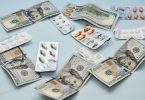Ellen Gabler writes for The New York Times about the risk of medication errors from using chain pharmacies, such as CVS and Walmart. At a larger level, Gabler’s story highlights the dangers of for-profit health care. With a desire to maximize revenues, health care corporations aim to do more for less. But, in the process, more too often means more harm to Americans.
Medication mix-ups have become increasingly common at chain pharmacies, which dispense about 70 percent of drugs in the US, along with supermarkets and megastores. Pharmacists have given people blood pressure medicine instead of asthma medicine, ear drops instead of eye drops and chemotherapy drugs instead of antidepressants. The chain pharmacies are very busy and understaffed, while under tremendous pressure to meet company quotes.
To drive profits, chain pharmacies expect pharmacists to push refills on patients who don’t need them and dispense more drugs than people need. For example, CVS pharmacists have been requested to dispense three-month supplies of some medicines–more pills means more money–to people with mental health issues. The American Psychiatric Association worries that dispensing so much medicine can lead to overdosing.
State pharmacy boards are hard-pressed to oversee these chain pharmacies to the extent necessary. They have little power to begin with. Often, representatives of the chain pharmacies sit on their boards. This creates conflicts of interest. Pharmacists fear losing their jobs if they speak up about issues. State legislatures do not seem to have the ability to regulate the pharmacies appropriately either.
Chain pharmacies, such as CVS, deny there is a problem. Shockingly, there is no way to know the frequency or gravity of medication errors. As with most health care information, reporting is not what it needs to be and a lot of errors never become public. They are settled between pharmacy and patient, with an agreement on the part of the patient to not disclose the settlement terms.
But, one Institute of Medicine study on medication errors conducted in 2006 found that they hurt at least 1.5 million Americans a year. And, Gabler compiled a long list of grievances filed by pharmacists to state boards, suggesting that pharmacists face grave difficulties ensuring they are filling prescriptions appropriately.
At the end of the day, it’s probably advisable to steer clear of chain pharmacies. In addition to evidence suggesting that they put you at greater risk of receiving the wrong medicines, they tend to be the most expensive place to get your drugs.
If you do use a chain pharmacy and your pharmacy misfills your prescriptions, do what you can to publicize it. Call your local newspaper and ask for an investigation. No company wants these errors broadcast. Over time, it could help lead to the company addressing the problem or new consumer protections.
Here’s more from Just Care:
- To save money on drugs, avoid chain pharmacies
- Millions safely import low-cost drugs from abroad
- One in three FDA-approved drugs have safety risks
- FDA permits doctors to implant untested medical devices at extreme risk to patients
- If you take supplements, beware of potentially serious supplement-drug interactions








But how can you tell if a prescription is properly filled? The pills have numbers (usually) but where can you look them up?
Great question. In some cases, the error will be evident. The pill bottle label will show a different medicine from the medicine you were prescribed. In other cases, the medicine in the bottle may be different from the medicine on the label. Every medicine has a number attached to it. You can do a google search to see the number of the medicine your doctor prescribed.